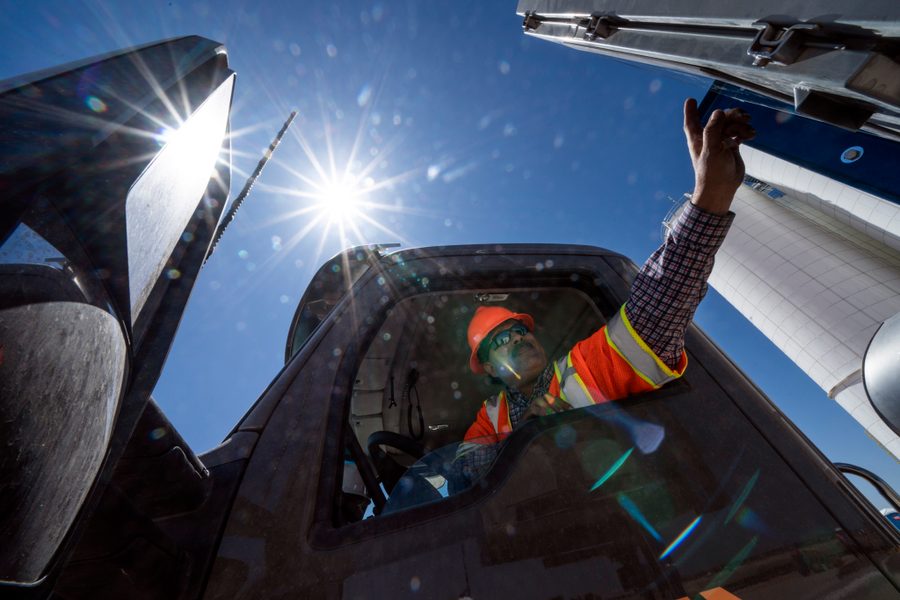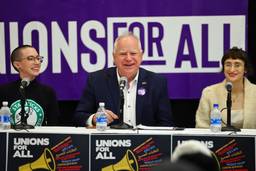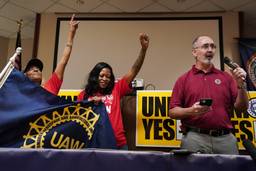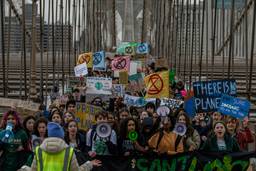Want to Know How We Can Win a Just Transition? States Hold a Key.
What’s next for the worker-led movement to curb climate change.
Mindy Isser

The climate justice movement has undoubtedly picked up steam in the last three years as talk of a Green New Deal has made its way into the mainstream. But even after uphill and innovative organizing, our federal government has not adequately responded to the serious and existential threat of climate change: The Build Back Better bill, touted by the Biden administration as our generation’s great hope for action on climate change, has been almost completely gutted in Congress, where it still awaits passage. And after the ultra-wealthy took private jets to and from the United Nations Climate Change Conference (COP26) in Glasgow, it does not appear that the urgent action we need will come any time soon. As temperatures increase and storms become worse, the environmental situation is even more dire: Humans can expect “untold suffering,” scientists warn, including mass extinction and death, if we don’t act fast.
Amid our elected leaders’ monumental failures, the climate justice movement has smartly moved its focus away from pet projects, like small-scale lawsuits, and towards organizing to build a movement with enough popular support to change our political system. To get the numbers we need — of workers in the many millions — it is necessary to ensure that climate solutions, whether it’s stopping coal extraction or halting fossil fuel digging, don’t abandon workers in those industries. This is the idea behind a “just transition,” which aims to move to an environmentally sustainable economy while making sure all workers have safe and dignified work.
State by state, organizers are working hard to make a just transition a reality and, fortunately, there are a few wins to point to. Unions and environmental groups won a joint victory this June, when the Climate and Community Investment Act, SB 999, passed in Connecticut. The legislation will do three important things: require prevailing wages for construction workers on renewable energy projects, ensure renewable energy projects create good, union jobs for Connecticut residents from disadvantaged communities, and negotiate community benefits agreements, which are agreements that describe a developer’s obligations to the broader community.
This state-level legislation is a step toward an urgent — and existential — need. Kimberly Glassman is the director of the Foundation for Fair Contracting of Connecticut, a non-profit organization that represents both building trades unions and union contractors to monitor public works’ projects for compliance with wage and other labor laws. She told In These Times, “As we transition away from fossil fuel dependent energy into green energy, [we have to make sure] that the workforce that has built their livelihoods in the fossil fuel industry has a way to transition and has access to good paying jobs in the green energy sector.”
There are positive signs beyond Connecticut. In October, Vincent Alvarez, president of the New York City Central Labor Council and a principal officer of Climate Jobs NY, and Pat Devaney, secretary treasurer of the Illinois AFL-CIO, co-wrote an op-ed about how workers and their unions are “making tremendous progress in advancing bold legislation at the state level to address [the] two existential crises” of climate change and extreme inequality. They pointed to major wins just this year: In Illinois, a climate bill puts the state on the path to a carbon-free power sector by 2045, with strong labor and equity standards. In Maine, unions won a project labor agreement on the state’s first offshore wind project. And in New York, unions built on the 2018 Climate Leadership and Community Protection Act by winning new labor standards, like increased protections for workers who are whistleblowers.
“Unions in four states have already demonstrated the power of a worker-led transition to a renewable energy future,” Alvarez and Devaney write. “We’re hopeful that more states — and Congress — will follow suit. Our future depends on it.”
Johnathan Guy, a climate organizer and graduate student worker and a UAW member at University of California, Berkeley, says that the Build Back Better bill may portend future state-level fights. “The biggest organizing opportunity that I see now is whatever infrastructure funding is filtered down to the states and cities. That presents the strongest and winnable set of campaigns, directing this money toward project labor agreements,” he told In These Times. He added, “To the extent that there is appropriations funding coming, that’s an organizing opportunity.”
Guy pointed to high-speed rail, solar panel projects, and renewable energy power plants in California as ways to marry the climate and labor movements, and to make good, green jobs a reality. It remains to be seen what kind of funding organizers can expect through the Build Back Better bill — if any — which could make it difficult to strategize or plan a campaign.
But it seems that even the most unlikely supporters see the need for action on climate. Glassman said that the building trades unions “are confronted with [climate change] every single day in their work. I don’t think there’s any question that the building trades recognize that the climate is changing, and they see it with stormwater runoff, with flooding, with the road work that needs to be done.”
But there’s still a lot of work to do. The climate movement, for the most part, is still far too isolated from the labor movement. Relatedly, the working class itself is far too unorganized, with fewer than 11% of workers in unions in the United States. That means that most workers don’t have the experience of taking action with other workers. And if we’re going to win something as massive as a just transition, millions of workers will need to both be on board with it and have the tools to make it happen.
This is why the Democratic Socialists of America (DSA), the largest socialist organization in the country at more than 90,000 members, chose to focus its work on passing the Protecting the Right to Organize Act (PRO Act), labor law legislation that would make it far easier for workers to form unions. (Disclosure: The author is an elected leader on DSA’s Labor Commission.) Much of this work has been housed in the organization’s Green New Deal campaign committee, which saw the PRO Act as an opportunity to build solidarity between climate and labor movements. “There was absolutely an understanding [among members] that we need to build working-class power specifically, and that the road to that flows through organized labor,” says Sean Estelle, former member of the national elected leadership of DSA and someone who helped design the long-term GND strategy process. As individuals, working class people are quite powerless — but in organizations like unions, they come together to be so much stronger than just the sum of their parts.
DSA members involved in environmental organizing — often known as “ecosocialists” — recognized that without an increase in both union members and union activity, the Green New Deal would remain, in House Speaker Nancy Pelosi’s words, “the green dream or whatever.” DSA members around the country fought hard to pass the PRO Act, together making 1 million calls, and their advocacy was applauded by the late Richard Trumka, president of the AFL-CIO. DSA members’ organizing seemed to play a role in pushing Sens. John Hickenlooper (D-Colo.), Angus King (I-Maine), and Joe Manchin (D-Va.) to publicly commit to support the legislation. Some parts of the PRO Act were included in the Build Back Better bill — for example, higher penalties for unfair labor practices. So there is some hope that DSA members’ hard-fought efforts could pay off, although it’s difficult to know what the final version of the bill will look like.
But amid a thorny political battle over the legislation on the federal level, the Green New Deal campaign committee transitioned its focus to Representative Jamaal Bowman’s Green New Deal for Public Schools Act, which aims to invest $1.43 trillion over 10 years in public schools and their buildings and infrastructure, in an effort to combat climate change, improve public education, and provide jobs in the education and construction sectors. While the larger progressive left like Sunrise Movement and Working Families Party (and of course DSA) came out in support of the legislation, these groups were not alone: They were joined by The Building and Construction Trades Council of Greater New York. Gary LaBarbera, the Trades Council President, said the legislation would “create thousands of jobs with good labor standards that will pave the way to the middle-class for countless hard-working Americans.” DSA chapters all over the country got involved in the campaign, working with teachers, building trades unions, and public school students and parents to push their local representatives to support the legislation.
It is easy to feel like things are grim — they are. And the climate movement has not won as much as it has intended to, nor as much as it desperately needs to. But statewide victories are so important — they build on each other, and they create momentum to keep the national work going during difficult times. They also give us practice and experience so we can eventually set our sights on bigger targets. One of the biggest critiques of Green New Deal-style politics is that they’re pie-in-the-sky. To show workers these goals are winnable — and can improve their lives — they need to actually win them. As Estelle puts it, organizers must “both build the power of organized labor and put forward a political vision too, while operating on the material terrain of the climate crisis.”








